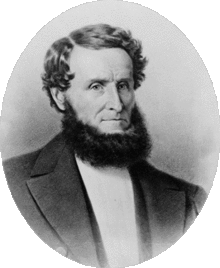James Lick
James Lick (born August 25, 1796 in Stumpstown (now Fredericksburg ), Pennsylvania , † October 1, 1876 in San Francisco ) was an American piano builder , landowner and promoter of science. At the time of his death, he was considered the richest man in California . He gave most of his estate to charitable or scientific purposes.
Lick, the son of a carpenter , learned the craft of carpentry at an early age. At the age of 21, after an unhappy romance with Barbara Snavely, he went to Baltimore and learned piano making. He quickly acquired the necessary skills, went to New York and opened his own company there.
When he found that his pianos were being exported to South America , he settled in Argentina in 1821 . Lick found his time in Buenos Aires difficult because of his refusal to learn Spanish and the troubled political situation. Still, his business was thriving and he decided to travel Europe for a year . On the way back, his ship was hijacked by the Portuguese , the crew and passengers were locked in a prison for prisoners of war in Montevideo . Lick managed to escape and he returned to Buenos Aires on foot.
In 1832 Lick decided to return to his hometown of Stumpstown. However, when the attempt to restart his relationship with Barbara Snavely failed, he again turned his back on the United States and settled again in Buenos Aires. However, the uncertain political situation led him to move to Valparaíso in Chile . After four years he moved on to the Peruvian capital Lima .
In 1846 he again decided to return to North America . Foreseeing the American-Mexican War and the annexation of California, he settled there. When his Mexican workers left him to join the Mexican army, he had to carry out an assignment for several pianos himself.
In January 1848, Lick went to San Francisco . He had his tools, a workbench, 30,000 US dollars in gold and 300 kg of chocolate with him. The chocolate was sold quickly and Lick persuaded his former neighbor from Peru, the confectioner Domingo Ghirardelli , to move to San Francisco and open a chocolate factory. The Ghirardelli Chocolate Company was born .
Immediately after his arrival, Lick began purchasing real estate . The discovery of gold at Sutter's Mill, near Sacramento , led to the California gold rush . This was associated with a real estate boom and the population of the formerly sleepy town of San Francisco grew to over 20,000 in 1850. Lick was first infected by the gold rush and began digging for the precious metal. But after only a week he realized that owning land was more effective than digging in the ground. Lick bought more and more land around San Francisco and San José , set up orchards and built the largest grain mill in the country to feed the rapidly growing population.
In 1861 construction began on a hotel , the Lick House in San Francisco. 400 guests could be seated in a dining room the size of the Hall of Mirrors at Versailles Palace . The hotel was considered the poshest west of the Mississippi River . It was destroyed in a fire in 1906 that followed the great earthquake .
In 1874, Lick sustained massive injuries when he fell in the kitchen of his Santa Clara home . For better care he was quartered in the Lick House. At that time he owned extensive holdings in Santa Clara County , San Francisco, around Lake Tahoe , a huge ranch in Los Angeles, and the entire island of Santa Catalina . Lick was the richest man in California.
For the next three years, Lick pondered what to do with his fortune. He envisioned huge statues of himself and his parents as well as the erection of a pyramid in his memory that would even surpass the pyramids of Giza . George Davidson, president of the California Academy of the Sciences, eventually persuaded him to invest most of his fortune in an observatory to be built on top of Mount Hamilton. The observatory should be equipped with the largest telescope in the world.
However , he did not see the Lick Observatory go into operation in 1888. He died in his room at Lick House in October 1876. In 1887 his body was buried under the large refractor of the observatory. A simple brass plaque bears the inscription: "Here lies the body of James Lick."
The lunar crater Lick and the asteroid (1951) Lick are named after him.
| personal data | |
|---|---|
| SURNAME | Lick, James |
| BRIEF DESCRIPTION | American piano maker, large landowner and promoter of science |
| DATE OF BIRTH | August 25, 1796 |
| PLACE OF BIRTH | Stumpstown (now Fredericksburg ), Pennsylvania |
| DATE OF DEATH | October 1, 1876 |
| Place of death | San Francisco |

